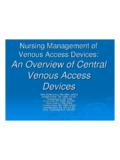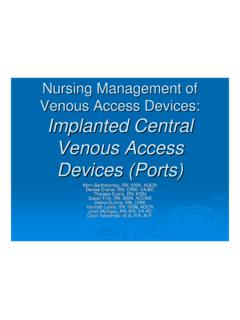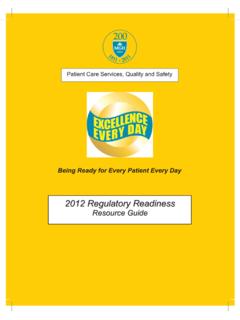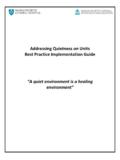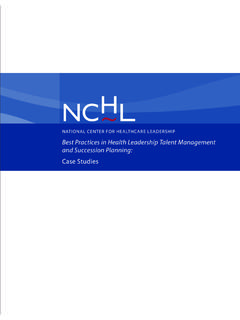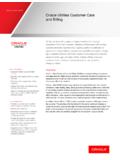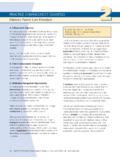Transcription of 4.18 Provide examples of how the performance …
1 Provide examples of how the performance appraisal process improves the practice of nurses at the direct care and the nurse administrative levels. One of the key Patient care Services Guiding Principles is that learning is a lifelong process essential to the growth and development of clinicians striving to deliver quality patient care . Evaluating practice is a fundamental component of learning that occurs on an ongoing basis throughout the year and it is formally integrated into the performance appraisal process. The MGH Department of Nursing employs two important appraisal processes to advance the practice of nurses at all levels of the organization - the annual performance review and the Staff Perceptions of the Professional Practice Environment Survey (SPPPE).
2 Staff Perceptions of the Professional Practice Environment Survey The Staff Perception of the Professional Practice Environment Survey (SPPPE) is an important tool used to evaluate and improve the practice environment. As described in Force and RD 4, the survey measures eight organizational characteristics documented in the literature as being influential in determining clinician satisfaction. Staff Nurses are provided with the opportunity to respond to multiple questions designed to Provide feedback and direction to the Chief Nurse and nursing leadership about the strategic goals set for the Department of Nursing, what is working and what needs improvement. A survey of Common Patient Problems is included in the SPPPE to understand the frequency of patient problems identified by clinicians and to better understand how well staff feel they are prepared to manage the problems.
3 Based on these data, interventions are designed throughout the year to improve the knowledge and skills of nurses as well as improve their access to resources in order to Provide better care to patients and families. In 2006, the top three patient problems are anxiety, risk for infection, and management of infection. Nursing leaders use results from the SPPPE to guide change, develop new strategies and programs, and generate questions that can improve nursing practice. In addition, the trend data from the SPPPE is used in developing the annual Patient care Services Strategic and Operating Plan. This annual plan reflects the performance improvement and program priorities for the upcoming year. 228 Annual performance Review The annual performance review is based on the MGH performance Evaluation System and the performance Evaluation policy (attachment ).
4 The evaluation is based on work performance relative to expectations and standards and the establishment and commitment to achievement of mutually defined goals. There are three components of the evaluation review for nurses: the performance appraisal tool, required training and the assessment of competencies. The performance appraisal tool is designed specifically to evaluate the practice of nurses in each nursing role group in a way that supports the growth and development of the individual nurse s practice. Using the tool as a guide, the nurse has the opportunity to self reflect on practice and is evaluated by a supervisor and peers to identify performance goals that focus on improving practice. The second component of the performance review is required training.
5 Each nurse must complete specific annual required training on topics related to their role. These may be mandated by accrediting agencies or identified as required by the hospital because of their importance towards providing or improving quality patient care . Required training topics include fire and safety training, electricity safety, hazard communication and general safety, emergency preparedness, and HIPAA training. The third component of the performance review is an assessment of competency. On an annual basis, the Competency Assessment Taskforce convenes to identify and recommend competencies for each nursing role group for the coming year. Taskforce members include members for all nursing role groups; the Associate Chief Nurses, Nursing Directors, Clinical Nurse Specialists, Operations Coordinators, Staff Nurse Chairs of the Nursing Practice Committee and Quality Committee, Staff Specialists, representatives from the PCS Office of Quality and Safety, and Management Systems Advisory Committee.
6 Competencies chosen address hospital and departmental strategic initiatives, quality and safety or workforce issues, regulatory requirements and/or practice issues. During the performance review process, each nurse completes a self-directed learning packet, pre- and post-test related to the required training and competency materials. This is reviewed with the nurse s supervisor during the performance review. Attachment is a copy of the Annual Competency Assessment for Direct care Providers. Competency Assessments and Annual Training Guides for all role groups are available for review on-site. 229 In addition to the core components of the annual performance review, there are unique elements of the performance appraisal process for each role group that support the ongoing improvement of nursing practice.
7 performance Appraisal: Staff Nurse The Staff Nurse performance appraisal process provides the nurse with an opportunity for self-reflection as a way to improve practice. Using the appraisal tool described in Force as a guide, the components of practice assessed are: clinical knowledge and decision-making, clinician/patient relationships, collaboration/team work and professionalism. The key feature of this process is the written clinical narrative. Nurses are asked to reflect and write about an event that they feel best exemplifies their current clinical practice. This may include: An experience that illustrates how an intervention made a difference in patient outcome, A clinical experience that was particularly demanding, An event or situation that captures the essence of the nurse s practice, or, A situation that the nurse confronts in practice and that gives new insight into their role as a professional clinician.
8 Once selected, the narrative is shared and used as a springboard for a discussion about the individual s practice. In an environment of trust, mistakes can be shared without fear of reprisal. Issues and themes of practice, as experienced by the nurse, are uncovered in a way that allows the nurse to translate events into a deeper knowledge and awareness about practice. During the review, the Staff Nurse with the Nursing Director and, at times, the Clinical Nurse Specialist, discuss the self-assessment and reflect on the nurse s practice to mutually establish professional goals for the upcoming year. The following are excerpts from Staff Nurse descriptions of how their performance appraisals have helped improve their practice: From the Post-Acute care Unit (PACU): For the past year I have been reflecting on my nursing practice and feeling that it may be time to formally move forward in the process to apply for the clinical scholar level of recognition.
9 My clinical knowledge has been fine tuned to an expert level in the area of post anesthesia care while I still possess the wide range of knowledge I have obtained throughout my 19 years at MGH. 230 It was during my discussion with my Nursing Director for my performance appraisal that I validated my thoughts on my level of practice and began to formulate a structured approach to my clinical scholar portfolio. It was he who helped me realize that the work I have been doing in the resource role has highly impacted the flow of patients through the PACU. We then discussed how to broaden that role to make an even greater impact. I have accepted the role as head of the resource committee with much encouragement from my Nursing Director.
10 This role has already allowed me the opportunity to broaden my relationship with my colleagues in the PACU. Through his positive reinforcement I have taken this role further and stepped outside of my comfort zone. I have set a number of personal goals one of which is to develop communication with leaders of other units and in doing so creating optimal flow and care of patients and their families through these units. This discussion was helpful for me in that I began a partnership with my Nursing Director to support my ability to achieve my goals for the upcoming year. We both discussed and agreed on what steps needed to be taken. My Nursing Director was clear with me on what he would do to support my work. From the Same Day Surgical Unit (SDSU): I have worked at MGH since 1978 and have been a perioperative nurse in the Same Day Surgical Unit since 1998.

